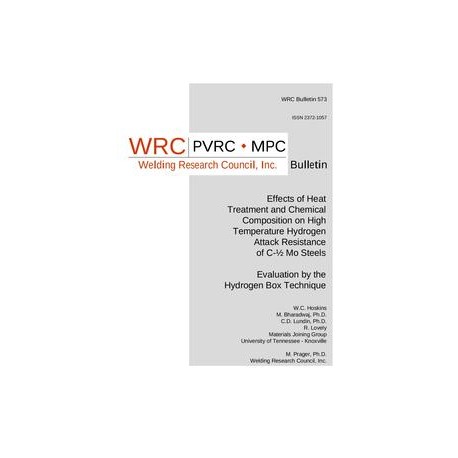Cart
0
Product
Products
(empty)
No products
To be determined
Shipping
$0.00
Total
Product successfully added to your shopping cart
Quantity
Total
There are 0 items in your cart.
There is 1 item in your cart.
Total products
Total shipping
To be determined
Total
New
Reduced price!
 View larger
View larger
 View larger
View larger
WRC 573
M00009494
New product
WRC 573 Effects of Heat Treatment and Chemical Composition on High Temperature Hydrogen Attack Resistance of C-1/2 Mo Steels
Bulletin / Circular by Welding Research Council, 2018
W.C. Hoskins, M. Bharadwaj, Ph.D., C.D. Lundin, Ph.D., R. Lovely, M. Prager, Ph.D.
In stock
More info
Full Description
High temperature hydrogen attack (HTHA) is a phenomenon which has plagued the petrochemical industry in applications where low alloy steels are employed in hot hydrogen environments (greater than 500F [260C]). Recent failures of equipment in hydrogen service stemming from HTHA damage have intensified the need for a further understanding of the behavior of low alloy steels in elevated temperature hydrogen environments. In this study, a unique autoclave hydrogen exposure experiment evaluated the effects of heat treatment and chemical composition on the HTHA resistance of Carbon- Molybdenum (C- Mo) steels. The autoclave hydrogen exposure experiment utilized a unique "HTHA box" that was designed to accurately simulate a hydrogen pressure differential through the wall thickness, as experienced by piping and vessels operating in hydrogen service. The C- Mo HTHA boxes were also fabricated such that there was a thick side and a thin side, which allowed the investigation of the performance of two different wall thicknesses with a unidirectional hydrogen concentration gradient. Using this box technique, two heats of C- Mo steel in the normalized and tempered (N Mo boxes were exposed at a temperature of 900F (482C) and hydrogen pressure of 900 psi (6.2 MPa) for 1248 hours. The conditions of the autoclave hydrogen exposure experiment were chosen to be severe in order to expedite HTHA damage. Subsequent to autoclave hydrogen exposure, the extent of HTHA damage was evaluated in each of the four C- Mo HTHA boxes by the following methods:(i) determination of the methane content as a function of distance from the hydrogen exposed surface,
(ii) characterization of metallography specimens using optical light microscopy (OLM) and scanning electron microscopy (SEM), and
(iii) fractographic examination of cryo-cracked samples using SEM.
The N Mo heats was also observed. The two materials selected in this study were chosen based on their molybdenum to carbon (Mo/C) ratio, such that the Mo/C ratio of one material was high (3.80) and the other was low (2.29). In the same heat treatment condition, the C- Mo steel with a higher Mo/C ratio exhibited superior performance (greater resistance to HTHA). C- Mo steels with a higher Mo/C ratio have a reduced carbon activity because of the formation of a greater fraction of thermodynamically more stable carbides, thus, reducing the propensity for methane formation. Apart from determining the effects of heat treatment and chemical composition on the HTHA resistance of C- Mo steels, a deeper mechanistic understanding of the morphological characteristics of HTHA damage was developed through the completion of detailed metallographic examination and the implementation of cryo-cracking to provide an enhanced view of intergranular HTHA damage.

